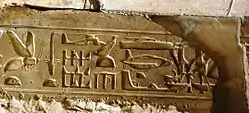Helicopter hieroglyphs
Helicopter hieroglyphs refer to an Egyptian hieroglyph carving from the Temple of Seti I at Abydos.

The "helicopter" image is the result of carved stone being re-used over time. The initial carving was made during the reign of Seti I and translates to "He who repulses the nine [enemies of Egypt]". This carving was later filled in with plaster and re-carved during the reign of Ramesses II with the title "He who protects Egypt and overthrows the foreign countries". Over time, the plaster has eroded away, leaving both inscriptions partially visible and creating a palimpsest-like effect of overlapping hieroglyphs.[1][2] As with all dates in Ancient Egypt, the actual dates of Seti's reign are unclear, and various historians propose different dates, with 1294 BC to 1279 BC[3] and 1290 BC to 1279 BC[4] being the most commonly used by scholars today.
In paleocontact hypothesis circles[5] the hieroglyphs have been interpreted as an out-of-place artifact depicting a helicopter (above the nine short vertical bars) as well as other examples of modern technology. This claim is dismissed by Egyptologists who highlight this pareidolia is partly based on widely distributed retouched images that removed key details from the actual carvings.
See also
References
| Wikimedia Commons has media related to Helicopter hieroglyphs (Temple of Seti I in Abydos). |
- "The Abydos temple "helicopter"". Archived from the original on 28 July 2005.
- "Helicopter Hieroglyphs Explained". raincool.blogspot.nl.
- Michael Rice (1999). Who's Who in Ancient Egypt. Routledge.
- J. von Beckerath (1997). Chronologie des Äegyptischen Pharaonischen (in German). Phillip von Zabern. p. 190.
- Darling, David. "paleocontact hypothesis". The Encyclopedia of Science. Retrieved 20 January 2013.